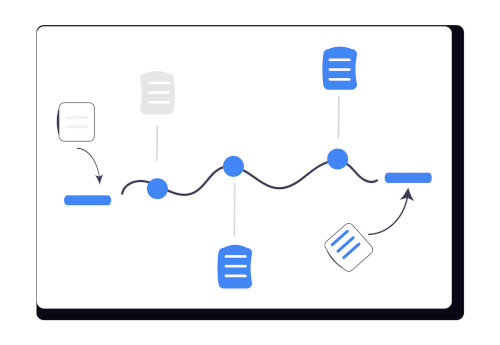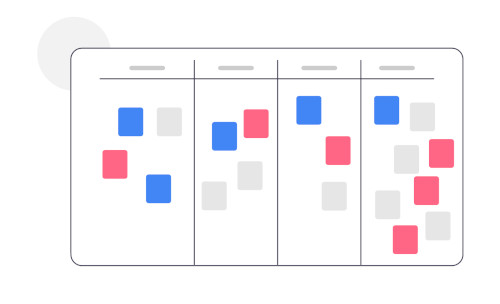Hybrid Models: The Strategic Fusion of Kanban with Other Frameworks

Hybridization in Agile and Lean delivery has moved from experiment to necessity for large organizations, as few of them can operate under a single framework, instead creating unique composite systems that selectively extract from multiple concepts to meet their needs. Among these, Kanban effortlessly becomes the connective medium; a neutral, adaptable backbone delivering visibility, and balanced, fact-based control to complex ecosystems.
Why is Kanban right for this purpose? Because it doesn’t impose team roles or process ceremonies. It’s a modular system for managing flow, illustrating work as it happens in real time, opening improvement opportunities through feedback, WIP limits, and continuous experimentation. As it neither disrupts governance nor attempts to compete with any existing practices, Kanban can be seamlessly merged with structured frameworks such as SAFe, DevOps, or ITIL, enriching them with its transparent, evolutionary properties to deliver coherent, end-to-end working models.
Why combine Kanban with other frameworks?

Align flow and structure
Structured frameworks, such as SAFe, Scrum, or ITIL, utilize set cadences, roles, and events to build process predictability, but demand seldom arrives in orderly rhythms. Kanban overlays a pull-based flow on those frameworks, letting tasks move continuously while still preserving governance and cadence. It makes a stable process more responsive.
Create transparency across workflow silos
Many companies rely on multiple delivery models at once: Agile for development, ITIL for operations, or DevOps for deployment, but this practice can often result in fragmented visibility. The Kanban system can cross these boundaries, presenting the work’s complete path without demanding strict model conformity. Only such a process overview can expose dependencies and impediments between the flows of the various structures a company uses.
Swap prescription for examination
Where traditional approaches define how teams should work, Kanban describes the workflow as it happens. A hybrid of the two builds an empirical management system with improvement based on observed data: cycle times, throughput, and flow efficiency, rather than on adherence to process ceremonies. It therefore allows evidence-based learning and experimentation.
Framework evolution, not revolution
The risks of introducing a new framework tie to organizational fatigue and cultural resistance, but Kanban brings changes that are evolutionary by nature: teams improve incrementally, using their current system in combination with Kanban. That makes Kanban hybrids uniquely suitable for large, highly regulated companies, where process change is closely controlled.
Connect strategy with delivery
Most process frameworks demand and regulate strategic alignment, but tracking its execution is challenging. Kanban directly visualizes the movement of strategic work through operational pipelines. Whether progress links to OKRs, team Kanbans, or value streams, its visualization gives your strategy measurability and adaptability, clarifying both plans and execution.

1: Kanban and SAFe (Scaled Agile Framework)
SAFe is a coordination mechanism for scaling agility across an enterprise, with the goal of increasing its responsiveness to change. Stemming from agile software development, lean product development, and systems thinking, SAFe provides a set of workflow patterns and team role guidance centered on alignment and cooperation. Some of its characteristic constructs are Agile Release Trains (ARTs) - a group of Agile teams aligned to meet a shared goal, Planning Intervals (PIs) - a period of 2-3 months during which a set objective is processed by the ART team, and Portfolio Kanban - a Kanban system for managing epics, or strategic initiatives.
Due to the inherent complexity of implementing large-scale business changes, many SAFe implementations face challenges with real-time visibility and adaptability between planning cycles. That’s where integrating SAFe Kanban can become a dynamic operational helping hand.
A Kanban-infused SAFe implementation creates continuous flow between PIs, decreasing idle time and supporting small-batch delivery within structured planning cycles. Adopting a pull-based flow helps prevent bottlenecks by letting work move forward only when the team has capacity, instead of batching tasks into fixed, time-boxed iterations.

Systemic benefits
- Better cross-team synchronization through shared Kanban boards across ARTs.
- Higher systemic bottlenecks detection with flow analytics, i.e., cumulative flow diagrams.
- Improved demand management across the portfolio, offering a balance between strategic epics and operational realities.
Embedding Kanban in SAFe can shift the paradigm from large-batch, event-driven delivery to a data-based, continuous flow model, without violating any of SAFe’s architectural and managerial constructs.
How does integrating Kanban with SAFe differ from SAFe’s built-in Portfolio Kanban?
SAFe’s incorporated Portfolio Kanban is a tool for governing the flow of Epics, a strategic intake and prioritization utility. It gives the visibility needed for investment decisions and strategic alignment; it applies at a high level - administrative, not operational.
A Kanban-SAFe hybrid, by contrast, uses flow-based management at all levels of work, employing Kanban principles (visualization, WIP limits, pull-based flow, and metrics such as lead time and throughput) to features, stories, and basic operational tasks within ART and its individual teams alike. This integration changes SAFe from a cadence-driven planning approach to a system for continuous, data-informed delivery.
In essence, SAFe’s Portfolio Kanban determines what work to pursue, while its integration with Kanban manages how work flows.

Who is Kanban + SAFe for? The Kanban-SAFe hybrid makes sense in large, multi-team organizations that rely on SAFe’s structure but want transparency, continuous flow, and responsiveness at all levels, from portfolio to program to team. It is well suited for release train teams, IT operations groups, service delivery teams, and support functions such as network or infrastructure management. It’s also a good fit for companies shifting from project-based, time-boxed delivery to continuous product value flow.
2: Kanban and DevOps
Where SAFe adds structure, DevOps provides speed and automation, insisting on close collaboration between software development and operations through the entire software lifecycle. But the DevOps approach alone does not guarantee optimal flow; while accelerating delivery, it can amplify existing inefficiencies if the workflow itself is left unclear and unmanaged. Kanban can serve as the governance layer for flow, connecting business demand and technical execution.
DevOps heavily relies on complete automation between code commit and deployment to production. Kanban can complement this by presenting the entire system of work, encompassing analysis, design, testing, deployment, operations, and support. Thereby, applied to a DevOps workflow, Kanban remodels it from a technical mechanism into a comprehensive management system. Its teams can now see queue buildups, release risks, and feedback loops - all in real time.

A significant portion of work in a mature DevOps environment is unplanned: defects, bugs, incidents, updates, or automation upkeep. Kanban provides a way to govern unplanned demand, balancing scheduled delivery with reactive operational needs using work-in-progress limits and explicit policies for triage and re-prioritization.
Kanban’s specific metrics - lead and cycle time, throughput, CFD - perfectly integrate with DevOps telemetry, jointly establishing quantitative feedback loops that bring together technical performance (e.g., deployment frequency, MTTR) with workflow performance (flow efficiency, predictability). As a result, a closed-loop improvement cycle is born to align business outcomes with pure engineering throughput.
Who is Kanban + DevOps for? The combination is ideal for technology delivery teams that already rely on automation and continuous integration/deployment, but wish for higher levels of visibility, balance, and governance of the flow of work, not just its speed.
3: Kanban and ITIL
ITIL: Information Technology Infrastructure Library, was created for IT service management, control, and alignment with business goals. Since ITIL environments can be criticized for high rigidity and procedural overhead, an injection of Kanban can add an evolutionary, adaptable mechanism to bring agility to IT service management, but without removing all the necessary governance.
Rather than altering ITIL roles or its three main categories: general, service, and technical management practices, Kanban overlays a visual, flow-driven control system to operate across the existing ITIL functions. Mapping them in a Kanban manner uncovers hidden queues and inter-dependencies, clarifying demand inflow, response capacity, and stale service tickets.
Each ITIL process has clear rules and escalation routes, receptive to further Kanban enhancements with explicit workflow policies: clear pathways for prioritization, WIP limits, and classes of service. Arming ITIL practices with clear rules for every step accelerates response times. It also builds compliance by ensuring consistent handling of work items.

Traditional KPIs of ITIL: resolution time, backlog volume, and SLA compliance, are delay indicators. The integration of Kanban provides critical flow metrics such as throughput, lead time distribution, and flow efficiency, supporting the proactive identification and resolution of bottlenecks. This combination converts ITIL from a reactive control structure into a predictive, flexible flow ecosystem.
Who is Kanban + ITIL for? This hybrid model suits teams that require strong control, compliance, and reliability - but also seek greater speed, responsiveness, and continuous improvement, such as IT operations, service desks, network support, and change management.
Further hybrid Kanban pairings
While SAFe, DevOps, and ITIL are the most common integration points for Kanban, its true versatility becomes evident when we examine the methods’ intersections with less conventional frameworks.
In these combination environments, Kanban serves as a unifying operational model, adaptive to the present nature of the workflow. It’s leveraged as a meta-framework: a scheme that enables evolution through observation and feedback, not imposition.
Did you know?
The Kanban Tool® web service makes introducing Kanban simple for any organization. Visualize work in real time, limit WIP, and bring transparency and flow to your teams, making your hybrid framework work seamlessly!
4. Kanban + Scrum = Scrumban
Scrumban is a common gateway for teams transitioning away from Scrum to a flow-based model, yet its value goes beyond a temporary framework. The hybrid lets teams retain Scrum’s cadence and structure - daily stand-ups, reviews, retrospectives, and sprints - while adding Kanban’s visualization and flow control.
The combination mitigates the most commonly encountered dysfunctions of Scrum: the stringent time-boxed commitments and the lack of a broad goal overview between sprints. In Scrumban:
- The workload of the sprint becomes a dynamic Kanban board, with items pulled based on capacity rather than set time-frames.
- WIP limits prevent over-commitment and enhance focus, especially for maintenance and support teams.
- A planning rhythm, e.g., sprint planning or weekly reviews, is retained for synchronization and reflection, while task flow is continuous.
Who is Scrumban for? Designed for environments with unpredictable demand or recurring interruptions, such as support and maintenance, Scrumban combines Scrum’s delivery discipline with Kanban’s adaptability to maintain flow and responsiveness.

5. Kanban and Lean Six Sigma
A marriage of Kanban’s qualitative insights with Lean Six Sigma’s statistical rigor lets organizations unlock a truly data-driven take on continuous improvement.
Kanban excels at pinpointing process inefficiencies, and Lean Six Sigma is perfect for diagnosing and removing their causes. Paired, they make up a closed-loop entity for observing, measuring, and optimizing.
For example:
- Using Kanban reveals process queues, systemic rework loops, and idle stages, while applying Six Sigma tools, such as control charts or regression analysis, quantifies variability and signals its sources.
- The flow metrics that come with Kanban form measurable baselines for Six Sigma’s DMAIC (Define, Measure, Analyze, Improve, Control) cycle.
- Improvements are applied iteratively, immediately shown on the Kanban board, and later validated through statistics.
Who is Kanban + Six Sigma for? The Kanban & Six Sigma combination is especially suited to highly regulated sectors, e.g., finance, healthcare, and manufacturing, where rigorous validation of process improvements is required, but teams also need to preserve agility and adaptability in their operations.

6. Kanban and OKRs
Translating strategic objectives into actionable work is always a challenge. The Objectives and Key Results framework was created to articulate goals and direction - Objectives, and to measure their realization - Key Results. However, without real-time flow tracking, the ambitions risk getting disconnected from daily operations. Kanban can fill in that disconnect by making strategy operational.
In a Kanban–OKR hybrid:
- Objectives are visualized as swimlanes or upstream Kanban workflows, split into deliverables that expressly contribute to Key Results.
- Tracking progress is shifted from subjective status updates to process data-based flow metrics of the OKR-aligned tasks.
- Teams gain insight into whether their current flow matches the strategic outcomes, which enforces dynamic prioritization at times when OKRs shift or change.
This hybridization creates strategic agility: management defines direction through OKRs, and teams execute it through Kanban, giving each work item a traceable strategic intent.
Who is Kanban + OKRs for? It’s for teams and companies looking to transform strategy into flow, especially in product development, portfolio management, daily business operations, as well as startups and innovation ventures.
7. Kanban and Design Thinking
The Design Thinking problem-solving technique centers on empathy, ideation, and experimentation - all inherently non-linear concepts. This approach to creative processes can suffer from poor visibility and unclear hand-offs, as well as speed variance between the exploration and delivery phases. Kanban can enrich it with clarity and structure void of rigidity, making Design Thinking Kanban a disciplined, creative workflow.

As part of this combination:
- Every Design Thinking stage: Empathize, Define, Ideate, Prototype, Test, is visualized on the Kanban workflow, presenting the journey ideas take to mature from research results to validated concepts.
- Being able to limit work-in-progress in ideation or prototyping stages prevents diffusion of creative effort across too many simultaneous experiments.
- Feedback from user testing or validation loops is immediately incorporated into the same visual flow, completing the cycle between discovery and delivery.
Who is Design Thinking + Kanban for? The hybrid will be effective for innovation labs, UX teams, or product discovery units that require an illustrative, adaptive tool for managing experimentation without excessively constraining creativity.
8. Kanban and PRINCE2
In strictly project-driven companies, a structured framework such as PRINCE2 (Projects In Controlled Environments) ensures governance and accountability, while highlighting decision points. A known weak spot of the framework is the somewhat delayed feedback and limited transparency of execution. Kanban is a natural choice for introducing flow visibility into this hierarchically managed environment.
- The project stages, from initiation through planning and execution, to closure, receive a corresponding Kanban layer, uncovering dependencies and bottlenecks for the project managers in real-time.
- WIP limits forbid project teams from starting new phases or deliverables before completing the current ones, preserving focus and reducing wasteful multitasking.
- Lead time measurement, derived from Kanban, feeds directly into project completion forecasting and risk mitigation models.
The resulting model is hybrid governance: PMs retain control and documentation discipline, while Kanban injects flexibility and continuous insight.
Who is PRINCE2 + Kanban for? Ideal for teams that must deliver within formal project structures and time-frames, yet want real-time flow visibility and higher focus; popular with traditional project management offices, engineering and construction project coordinators, as well as strongly governed enterprises, such as defense or finance.
9. Kanban + HCCM
Human-Centered Change Management frameworks, such as ADKAR or Kotter’s 8-Step Model, can benefit significantly from Kanban’s visual approach. Change initiatives, no matter how empathetic to our natural resistance to new ways of working, are often abstract and diffuse. That’s exactly what Kanban can provide a tangible structure for, facilitating better understanding of the change, and allowing its implementation tracking.

For instance:
- Each change initiative - Awareness, Desire, Knowledge, Ability, and Reinforcement - can be mapped as a separate value stream, showing the feedback loops to all involved.
- High-level WIP limits prevent overloading teams with concurrent transformations, pacing them sustainably.
- Survey results, adoption metrics, and strong resistance points can become inputs into the Kanban system, creating a real-time dashboard of organizational change, feeding continuous improvement.
Who is HCCM + Kanban for? This joining is especially valuable for large companies undertaking cultural or structural transformations, where visibility, feedback, and adaptability are critical for success. Examples include Agile transformation offices, HR departments, program management teams, and all “People-first” companies.
How to create an effective hybrid?
A marriage of two work management frameworks can only succeed when it is intentional; while merely layering systems upon systems is likely to create friction if their philosophies, or tooling conflict. The following principles can help ensure effective integration:
Step 1: Define the purpose:
Describe what problem the hybridization is meant to solve - is it visibility, predictability, collaboration, throughput, or governance?
Step 2: Retain the native cadence of each framework.
For example, maintain the Planning Intervals of SAFe, but allow Kanban to manage flow within cycles.
Step 3: Unify metrics.
Define a unified set of performance metrics and terminology to enable cross-framework analysis and capture the best insights from each system.
Step 4: Avoid ceremony compounding.
As Kanban does not require additional meetings and new roles, it can seamlessly integrate with existing ceremonies.
Step 5: Start with visualization, not policy.
The primary purpose of combining frameworks is to increase work visibility, while policies should develop iteratively, guided by data from the observed flow of work.
In short, you don’t want to mix methodologies arbitrarily, but synthesize them into a coherent operating model, combining structure with adaptability.

The strategic payoff of hybrid Kanban systems
The value of Kanban hybrids lies in their organizational coherence. It’s common for companies to fragment across competing frameworks - Scrum teams, ITIL operations, SAFe portfolios, DevOps pipelines - each with a unique language and metrics. Kanban acts as the common language of flow, marrying other approaches through visibility and ongoing improvement.
The result is a delivery system that is:
- Empirical: driven by fact-based flow metrics, not assumptions.
- Adaptive: capable of changing without disruptive transformations.
- Cohesive: pairing strategy with execution across frameworks.
- Predictable:: offering measurable throughput and reliability, even in dynamic environments.
Kanban’ power comes as much from its simplicity as from its compatibility; instead of competing with other frameworks, it augments them to bring transparency, flow, and continuous improvement. Kanban becomes the nervous system of adaptive delivery in complex and volatile organizations.
Further reading
- Agile Methodologies In-Depth: Delivering Proven Agile, SCRUM and Kanban Practices for High-Quality Business Demands (BOOK)
- Effective Project Management: Traditional, Agile, Extreme, Hybrid (BOOK)
- Customizable Agile Development: Crafting Innovative Agile Frameworks to Suit Your Business Needs (BOOK)
- Kanban and Scrum - making the most of both (Enterprise Software Development) (BOOK)
- SAFe 4.5 Reference Guide: Scaled Agile Framework for Lean Enterprises (BOOK)
- Improving Strategic Traction Through an OKR Kanban System (web article)
- Hybrid Agile-Kanban frameworks for workflow adaptability: A proposed solution for innovation in project management (research article PDF)
- A framework for aligning strategy and execution (Project Management Insititute Conference Paper)